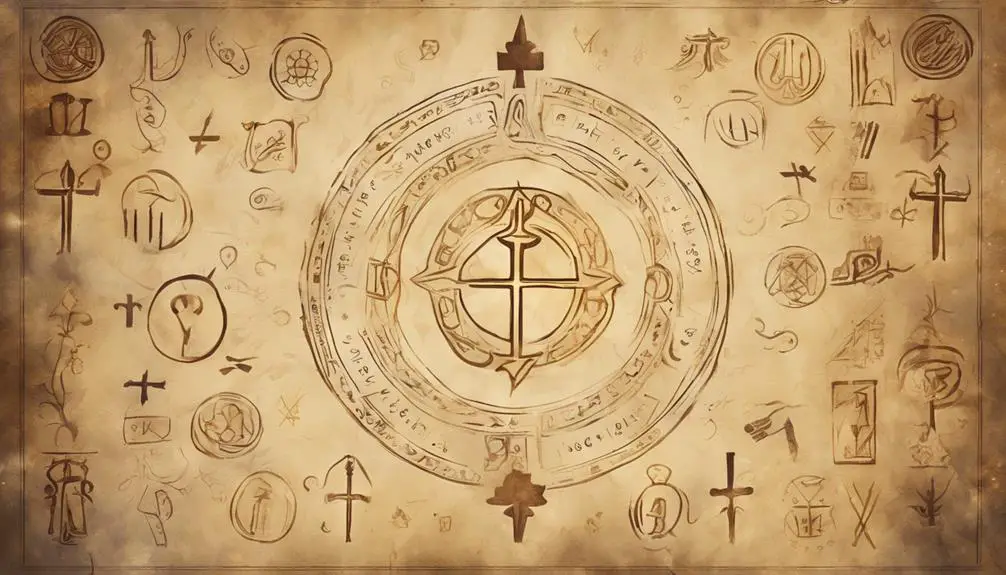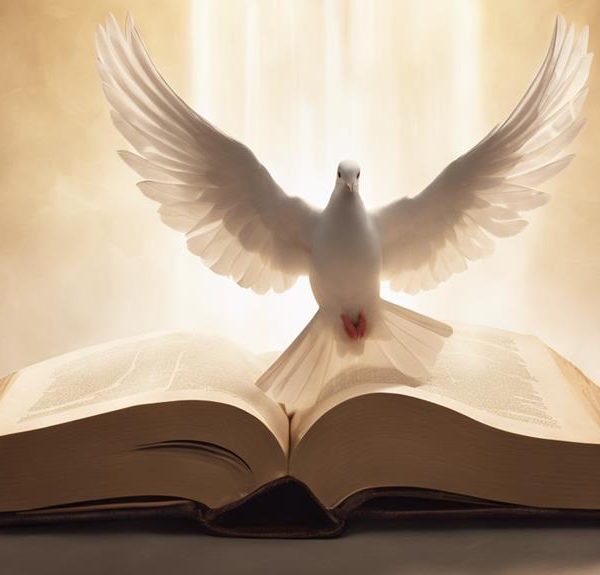Biblical sticks carry deep symbolism, from authority to miracles, revealing unexpected layers of meaning that invite further exploration.

What Does a Stick Represent in the Bible
You might think a stick is just a mundane object, but in the Bible, it holds profound symbolism across various narratives.
From a symbol of authority wielded by Moses to an instrument of punishment, the stick transcends its simple form.
It's not only an emblem of miracles, demonstrating God's power, but also represents guidance, protection, and the tender care of a shepherd.
As we explore these facets, you'll uncover layers of meaning that could shift your perspective on this seemingly ordinary object.
Let's unearth the depth of its significance together, and you might find yourself surprised by what lies beneath the surface.
Key Takeaways
- Sticks symbolize authority, leadership, and divine approval, often depicted with rulers and prophets.
- They serve as instruments of punishment and justice, reflecting societal or divine disapproval.
- In the Bible, sticks represent miracles and divine intervention, embodying faith and divine will.
- They also signify guidance, protection, and provision, offering spiritual assurance and support.
Symbol of Authority

In biblical contexts, a stick often symbolizes authority, serving as a tangible representation of power and leadership wielded by figures such as shepherds, kings, and prophets. The utilization of a stick, especially in the form of a royal scepter, stands as a testament to its significance within the hierarchies of ancient societies. This object doesn't merely serve a ceremonial purpose; it's an emblem of the right to rule and command, deeply intertwined with the concept of divine approval. Kings and rulers are frequently depicted with scepters in hand, signifying their dominion and governance over their subjects.
Moreover, the stick's representation extends into the realm of tribal identity. In several instances, it acts as a marker of lineage and tribal affiliation, illustrating the collective authority and unity of a group. This aspect emphasizes the stick's role in not only individual but also communal authority, highlighting its multifaceted symbolism in biblical narratives. Thus, the stick, whether as a royal scepter or a marker of tribal identity, encapsulates the complexities of authority, power, and governance in the biblical world, offering insights into the social and political structures of the times.
Instrument of Punishment

Beyond its symbolic representation of authority and lineage, a stick also serves as an instrument of punishment within biblical narratives, reflecting its multifaceted role in the enactment of justice and discipline. This utilization underscores the complex nature of the stick, not merely as a passive emblem, but as an active participant in the frameworks of correction and moral instruction. Within the context of ancient societies, the use of a stick as a correction tool wasn't merely punitive but was also seen as a means to guide individuals back onto a path of righteousness and communal harmony.
The application of a stick in disciplinary measures within the biblical texts often carries with it a dual message. On one hand, it represents the immediate consequence of transgression, a tangible manifestation of societal or divine disapproval. On the other, it symbolizes the hope for correction, the belief in the possibility of change, and the reclamation of one's place within the moral order. This dual nature of the stick as both a tool of punishment and an instrument of potential redemption highlights its significance within the biblical tradition, serving as a powerful reminder of the balance between justice and mercy, discipline and forgiveness.
Emblem of Miracles

While the stick symbolizes correction and discipline, it also emerges as a powerful emblem of miracles within the biblical narrative, embodying divine intervention and the supernatural. Through these narratives, you observe how sticks aren't merely physical objects but instruments through which faith manifestation and divine will are enacted.
The stick's role in miracles is multifaceted, revealing:
- Authority over nature – Moses' staff transforms into a serpent and parts the Red Sea, demonstrating God's dominion over the natural world.
- Symbol of divine provision – Elisha uses a stick to cause an iron axe head to float, illustrating God's provision in times of need.
- Power to heal and restore life – The prophet Elisha's staff, though initially ineffective without his presence, signifies the potential for divine healing.
- Instrument of divine judgment – Aaron's rod blossoms and consumes the rebels' offerings in Numbers 17, underscoring God's ultimate authority and judgment.
These instances highlight the stick as not just an object, but as a conduit for divine intervention, underlining the profound relationship between faith manifestation and the divine. Through this lens, the stick transcends its physical form, becoming a testament to the power and presence of the supernatural in the biblical world.
Guidance and Protection

Through biblical narratives, sticks not only serve as symbols of correction and divine miracles but also embody guidance and protection for those who follow God's path. These seemingly simple objects transform into instruments of divine direction, steering individuals towards safety and righteousness. In the hands of the chosen, a stick becomes more than a physical object; it represents God's omnipresence, offering a tangible connection to His will and direction.
Moreover, sticks often act as pathway markers, guiding followers through spiritual or physical wilderness. This symbolism is crucial in understanding how believers navigate their journey, relying on God's guidance to avoid pitfalls and dangers. The metaphor extends beyond mere navigation, suggesting a deeper, spiritual guidance that aligns one's path with divine intentions.
Analyzing these narratives, it's clear that the stick's role in guidance and protection is multifaceted. It not only provides physical support and defense but also spiritual assurance that one is never alone when aligned with divine will. This dual function underscores the stick's significance, reinforcing its place as a powerful symbol of God's provision and care for His followers.
Shepherd's Care

In biblical narratives, the shepherd's staff emerges as a profound symbol of care and leadership, illustrating how divine guidance manifests in the lives of believers. This emblematic tool not only signifies authority but also underscores the intimate relationship between the shepherd and the flock, highlighting the themes of divine companionship and flock unity. Through this lens, the staff isn't merely an object; it becomes a representation of the shepherd's commitment to nurture and protect.
The significance of the shepherd's care is multifaceted, encompassing:
- Guidance: The shepherd leads the flock to pastures and water, symbolic of divine direction in life's journey.
- Protection: The staff is used to ward off predators, illustrating the protective nature of divine companionship.
- Rescue: When a sheep strays, the shepherd uses the staff to retrieve it, emphasizing the importance of flock unity and the individual's value.
- Discipline: It serves as a tool for correction, ensuring the well-being of the flock through careful oversight.
Thus, the shepherd's staff, in its essence, encapsulates the profound care and leadership inherent in divine guidance, serving as a tangible reminder of the shepherd's role in preserving flock unity and ensuring the welfare of each member.
Frequently Asked Questions
How Does the Transformation of a Stick Into a Serpent in Biblical Stories Symbolize the Dual Nature of Power and Danger?
In the biblical narrative, the transformation of a stick into a serpent represents the dual nature of power and danger. This magical transformation highlights the potential for both creation and destruction.
Serpent symbolism further adds layers, often associated with wisdom and malevolence. You're witnessing an allegory for the complexities of wielding power, where the miraculous can quickly turn menacing.
It's a cautionary tale, emphasizing the responsibility that accompanies great power.
In What Ways Does the Concept of a Stick or Rod Differ When It Is Referenced in Prophetic Visions Versus Historical Accounts Within the Bible?
When examining prophetic visions versus historical accounts in the Bible, you'll notice that sticks or rods embody different meanings. In prophetic symbolism, they often signify divine guidance or judgment, reflecting a deeper, spiritual layer of interpretation.
Conversely, within historical context, these objects are more grounded, representing authority, leadership, or punishment in a tangible, everyday sense. This distinction highlights the Bible's rich layering of symbols across various narrative frameworks.
Can the Significance of a Stick in the Bible Be Related to Any Similar Symbols Found in Other Ancient Religions or Mythologies?
You're exploring how the Bible's depiction of a stick finds echoes in other ancient traditions, focusing on cultural parallels and mythological significance.
By examining these cross-cultural connections, you'll uncover shared symbols that transcend individual religions or mythologies.
This analytical approach reveals that sticks often symbolize authority, guidance, or even divine intervention across various cultures, highlighting a universal aspect of human spirituality and its expression through common symbols.
How Do Modern Interpretations of the Bible Reconcile the Symbolic Use of Sticks With Contemporary Values and Beliefs?
You're exploring how contemporary scholars interpret the symbolism of sticks in the Bible, integrating modern ethics and cultural adaptation. This involves analyzing texts through a lens that balances traditional meanings with today's values and beliefs.
Scholars seek to understand these symbols not just in historical context but how they resonate or conflict with current societal norms.
This process demonstrates the dynamic nature of religious interpretation, marrying ancient symbols with modern perspectives.
What Is the Role of Sticks in Biblical Ceremonies and Rituals, and How Has This Role Evolved Over Time in Christian Practices?
In exploring the role of sticks in biblical ceremonies and rituals, you'll find the shepherd's staff notably symbolizes guidance and leadership.
This element has evolved, maintaining its symbolic presence in Christian practices, particularly in ceremonial purification processes.
Over time, the staff's representation has broadened, reflecting not only pastoral care but also spiritual cleansing and protection, demonstrating its enduring significance in the fabric of religious ceremonies and traditions.
Conclusion
In conclusion, through its multifaceted representations, the stick in the Bible symbolizes authority, punishment, miracles, guidance, and shepherdly care.
As an emblem of divine and earthly power, it serves as a tangible expression of God's will and human governance. Its role in delivering punishment underscores the justice system of ancient times, while its association with miracles highlights God's intervention.
Moreover, its depiction in guidance and protection reflects the providential care extended to the faithful, illustrating the shepherd's attentive presence among his flock.



Sign up